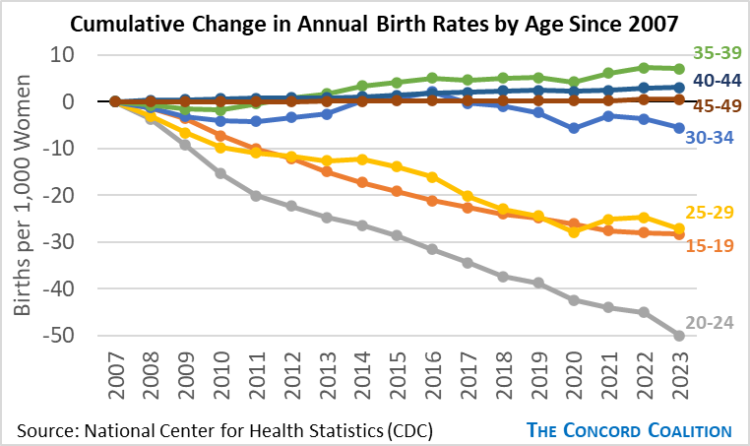Last week the National Center for Health Statistics reported the total fertility rate was 1.62 in 2023. That’s the lowest rate ever recorded in the United States and well below the rate needed to maintain a growing population.
As The Concord Coalition has previously noted, the fertility rate is important because it determines – along with net immigration and average life expectancies – whether the total population will rise or fall in the future. A rising population contributes to economic growth, increases the ratio of workers to retirees, and makes it easier to fund programs like Social Security and Medicare. A declining population does the reverse.
The average number of births needed to maintain a constant population is 2.1 births for each woman over her lifetime. (The number is more than 2.0 because not every woman lives to the end of her childbearing years and there are slightly more boys than girls born each year.) The results reported last week seem to suggest the U.S. population will eventually decline. But this conclusion overlooks the distinction between annual births which determine “period” fertility rates, and cumulative births which determine “cohort” fertility rates.
Period rates count annual births to women of all ages in a single year. That’s the number reported last week. Cohort rates count the total number of births that occur over the lifetime of all women born in the same year. That number can only be determined after each birth cohort of women reaches the end of their childbearing years. In theory, these two rates could be the same, if the annual number of births per woman at each age remained constant over time, but that’s unlikely to occur.
When the period rate is falling as it has been in recent years, that indicates one of two possible outcomes. Either women have decided to have fewer children overall, and the cohort rate will fall as well; or women have decided to have fewer children now and more children later, in which case the cohort rate will not fall.
One way to assess the relative likelihood of each outcome is to consider how annual birth rates are changing among women of different ages. If birth rates are falling at every age, that might suggest women are going to have fewer children overall. If birth rates are falling at younger ages and rising at older ages, that might suggest younger women are delaying childbirth until they are older.
The figure below shows the cumulative change in annual birth rates by age since 2007, which is the last time the period fertility rate was slightly more than 2.1. Birth rates have declined significantly among younger women, while birth rates among older women have increased slightly or stayed the same. The cumulative decline among women under age 35 is equivalent to 550 fewer lifetime births per 1,000 women, whereas the increase among women ages 35 and older is equivalent to 50 additional lifetime births per 1,000 women. [Fertility rates are the sum of age-specific birth rates, either cross-sectionally (period) or longitudinally (cohort).]

Declining birth rates among younger women, without an offsetting increase in birth rates as they get older, will cause future cohort fertility rates to approach the historically low level of the current period fertility rate. Unless these trends are reversed, or offset by higher immigration and rising life expectancies, the U.S. population will decline.
A declining population means fewer workers will be available to support future retirees, thereby increasing the burden of funding programs like Social Security and Medicare. Addressing this challenge will require policymakers to consider the relative trade-offs between encouraging more births, allowing more immigration, increasing retirement savings, and delaying early retirement. Given the nation’s current unsustainable fiscal path, these trade-offs should be confronted sooner rather than later. It would be far less difficult to make gradual changes now than to ignore these trends and be left with a population decline that would be harder to counteract or reverse in the future.




